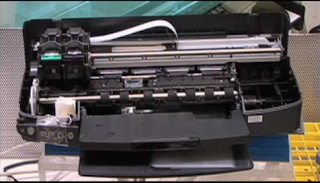Atala explained the process whereby scanners build a 3-D image of the kidney, then a tissue sample smaller than a postage stamp was used to seed the process. The organ printer then built the kidney layer-by-layer, creating an almost perfect replica of the patient’s tissue.
The organ-printing process employs scanners that collect a 3-D image of the organ that needs to be replaced. A small tissue sample seeds the printer, which replicates the tissue layer by layer to build a new organ, all in about six or seven hours. It would use the patient’s own tissue, so it avoids any organ rejection issues.
During Atala’s talk, a specially designed printer was about three hours into printing a kidney model built out of biocompatible materials. He also brought a completed model to show to the audience.
Initial reports suggested Atala had printed a working kidney, but it was actually a kidney-shaped mold with no internal structures or vasculature, according to Wake Forest University Baptist Medical Center, where Atala is a regenerative medicine specialist.
He said someday, scanners and printers could conceivably be used to treat wounds. A flatbed scanner could scan a patient’s wound, while a printer adds the right types of tissues to fill it back in. “You can print right on the patient,” Atala said, according to a report on the talk at Fast Company.
Atala also described using a patient’s failed organ as a scaffold for a new version, filling it with new tissue. This could help address the challenge of building blood vessels, which remains one of the greatest challenges in tissue engineering.
Atala said about 90 percent of people on organ transplant lists are waiting for kidneys, but donors are few and far between. Meanwhile, patients must undergo painful and complicated dialysis treatment. And mechanical replacements are still a few years away. Atala said regenerative medicine could one day solve the organ shortage crisis, replacing failing body parts on demand.
Older talk from 2009
If you liked this article, please give it a quick review on ycombinator or StumbleUpon. Thanks

Brian Wang is a Futurist Thought Leader and a popular Science blogger with 1 million readers per month. His blog Nextbigfuture.com is ranked #1 Science News Blog. It covers many disruptive technology and trends including Space, Robotics, Artificial Intelligence, Medicine, Anti-aging Biotechnology, and Nanotechnology.
Known for identifying cutting edge technologies, he is currently a Co-Founder of a startup and fundraiser for high potential early-stage companies. He is the Head of Research for Allocations for deep technology investments and an Angel Investor at Space Angels.
A frequent speaker at corporations, he has been a TEDx speaker, a Singularity University speaker and guest at numerous interviews for radio and podcasts. He is open to public speaking and advising engagements.


